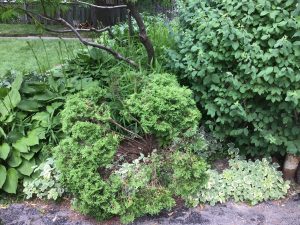
What, if anything, can be done, about this ‘floppy’ globe cedar? It’s planted along a driveway under a sumac tree and beside a honeysuckle shrub. In addition to rain it receives water from a downspout.
Did your globe cedar grow out in this way naturally? We had a question along these lines from someone further north in Ontario whose globe cedar had sustained some damage from the weight of a heavy snowfall, and in that case one of the options given was to tie the branches gently to bring them back into an approximation of their original shape. The other was to gently prune new growth on the inside of the plant in the spring to encourage fuller branching, which will take place slowly.
There are no obviously broken branches to be observed in your photograph, and your cedar appears otherwise very healthy, but it does look as though it may have been stepped on, separating its branches, and widening its structure without damaging the cedar itself. If you wish to try one of the above methods to try to reshape it, fertilising with a 10-8-6 formulation would also be helpful in spring. Right now you can keep your globe cedar healthy by mulching with compost to provide optimum soil nutrients, and/or with plain (not dyed) cedar mulch to help retain moisture and prevent weed competition.
It is worth mentioning the size of the mature globe cedar. If yours is one of the dwarf cultivars, it may already have reached its final size. But if it is a variety that grows bigger, you may want to consider replacing it if you cannot revive its shape. Globe cedars range in mature size from the large ‘Woodwardii’ which can reach 4-8 feet and 10 feet wide, to varieties such as Rheingold,” “Fire Chief,” and “Little Giant” which all become approximately 2-4 feet high and wide, and the smallest dwarf globes such as “Danica” , “Teddy” and “Mr. Bowling Ball” , which will only get from 1-2 feet high and wide. It is also worth noting that some cultivars do require light pruning to maintain their shape.
Sadly, there is no instant or sure fix for a globe cedar that has lost its shape in this way. You may want to try to reshape it using the methods given above, but if you are looking for a quicker result, it may make sense to replace this plant with one of the dwarf globe cedars readily available.

